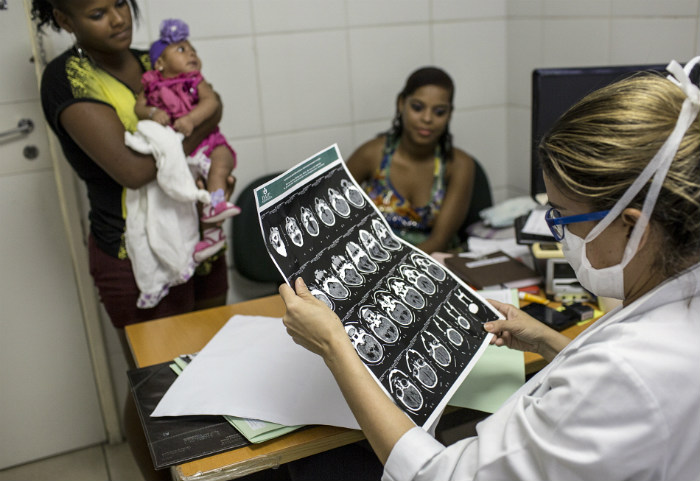By: Robert Colvile
Send to a friend
The details you provide on this page will not be used to send unsolicited email, and will not be sold to a 3rd party. See privacy policy.
Laura Rodrigues, a professor of infectious disease epidemiology at the London School of Hygiene & Tropical Medicine in the United Kingdom, is studying mothers and babies affected by the mosquito-borne Zika virus in Brazil. She talks about her work on the front-line of the Zika crisis and her investigation into possible links between the disease and babies born with abnormally small heads, a condition known as microcephaly, and underdeveloped brains.
Where are you at the moment?
I’m in the city of Recife, on the eastern tip of Brazil. It’s the capital of Pernambuco, the state at the centre of the Zika epidemic.
Was anyone prepared for this?
Not at all. It came as a surprise to the world! Across Pernambuco, there used to be nine cases of microcephaly a year. Since the beginning of August 2015, more than 1,400 suspected cases have been noted. And the Zika season is likely to start again. The rainy season brings water, and the mosquitoes lay their eggs in any little bit of water they can find.
What is your research trying to find?
We’ve got three studies under way. The first is examining the causes of microcephaly — the strongest hypothesis is Zika infection, but we need to be completely sure. The second is to identify the exact risks to women in terms of the stage of pregnancy they are at when exposed to Zika. And the third is to see how the babies develop.
How do the trials work?
We’re in very close contact with maternity hospitals across the state. So for the first study, when a baby with microcephaly is born, we’ll interview the mother about Zika exposure during pregnancy and collect blood samples, when possible from the umbilical cord. We measure the head circumference and get CT scans of the baby’s brain. We also follow the same process for a control sample of similar babies born without microcephaly and we study some babies who were born with microcephaly before the Zika outbreak.
For the second study, we’re recruiting pregnant women who get the kind of rash associated with Zika. We investigate them for Zika, dengue and chikungunya, which are all spread by the Aedes mosquito. Then we follow them to establish what proportion will have a miscarriage or a stillbirth, and what proportion have a baby with microcephaly or other malformations. That will tell us how common microcephaly really is and how it is affected by the trimester in which the mother becomes infected.
For the third study, we want to track the babies’ developmental delays, looking at things like whether they have convulsions and how they interact or make eye contact.
How did you get involved?
I’m the lead for collaborations with Brazil at the London School of Hygiene & Tropical Medicine. I’m Brazilian myself: I trained here, went to London for postgraduate studies and returned here to continue my career. When the epidemic started, the government asked a group of epidemiologists in Pernambuco to think about research projects. The Brazilian Ministry of Health invited me to come. The government gave us enough money for one of the studies, and we’re raising money for the others.
Who are you working with?
Our group is based at the local branch of the Oswaldo Cruz Foundation, which is a large research institute funded by the government. We have ten professionals in our group and 14 health visitors who go out to hospitals or take a van to visit women at home, although two of these workers are off sick with Zika at the moment. We’re working very closely with local hospitals.
What are you hoping to achieve?I think the key thing is finding out when people are most vulnerable to Zika, and what proportion of babies are affected. If it turns out that 90 per cent of women who get infected with Zika at a particular, critical stage of pregnancy have an affected baby, as happens with rubella, then there’s good reason to start thinking about a treatment as well as a vaccine — or maybe the option for women to have access to a legal termination. The other aspect in those decisions is how severe the children’s disabilities are going to be.
What’s the mood like?
When I was first here in November, it felt a little like Europe during the plague: there was this very scary new health trend, and people didn’t really know what was causing it. The government has done a good job getting information out there, but there’s a lot of concern. Families are very worried. The state has set up centres for pregnant women to self report for investigation and notification: over 1,000 presented in the last two months. But there is no treatment. Abortions are illegal in Brazil, so once a person is pregnant and infected, there’s nothing that can be done. In our team, we’re obviously very sad for the mothers and the kids, but this gives our work a sense of urgency.
View the Wellcome Trust's new video on Zika:
The Wellcome Trust provided initial funding for Rodrigues’s work.
This is an edited version of an article that first appeared on the Wellcome Trust blog. It is published under a Creative Commons CC BY 4.0 licence.














